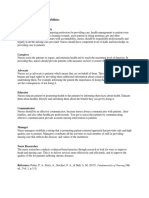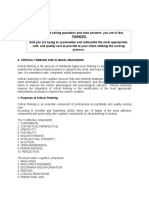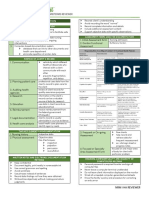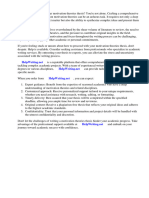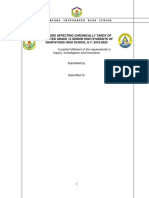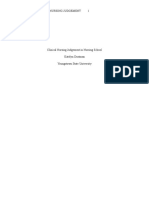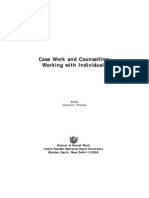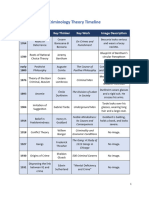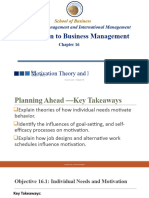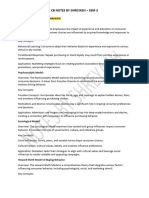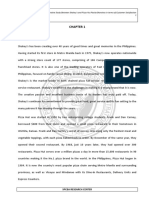CONCEPTUAL AND THEORETICAL PRINCIPLES IN NURSING
SELECTED NURSING PRINCIPLES
Introduction
Nursing theories are organized bodies of knowledge to define what nursing is, what nurses do,
and why they do it. Nursing theories provide a way to define nursing as a unique discipline that is
separate from other disciplines (e.g., medicine). It is a framework of concepts and purposes
intended to guide nursing practice at a more concrete and specific level.
Theories are composed of concepts, definitions, models, propositions & are based on
assumptions. They are derived through two principal methods; deductive reasoning and inductive
reasoning. Nursing theorists use both of these methods.
Importance of nursing theories
Nursing theory aims to describe, predict and explain the phenomenon of nursing (Chinn
and Jacobs1978).
It should provide the foundations of nursing practice, help to generate further knowledge
and indicate in which direction nursing should develop in the future (Brown 1964).
Theory is important because it helps us to decide what we know and what we need to
know (Parsons1949).
It helps to distinguish what should form the basis of practice by explicitly describing
nursing.
The benefits of having a defined body of theory in nursing include better patient care,
enhanced professional status for nurses, improved communication between nurses, and
guidance for research and education (Nolan 1996). In addition, because
The main exponent of nursing – caring – cannot be measured, it is vital to have the theory
to analyze and explain what nurses do.
As medicine tries to make a move towards adopting a more multidisciplinary approach to
health care, nursing continues to strive to establish a unique body of knowledge.
This can be seen as an attempt by the nursing profession to maintain its professional
boundaries.
The characteristics of theories
Theories are
1. interrelating concepts in such a way as to create a different way of looking at a particular
phenomenon.
2. logical in nature.
3. generalizable.
4. bases for hypotheses that can be tested.
5. increasing the general body of knowledge within the discipline through the research
implemented to validate them.
6. used by the practitioners to guide and improve their practice.
7. consistent with other validated theories, laws, and principles but will leave open
unanswered questions that need to be investigated.
1
�Common concepts in nursing theories
Four concepts common in nursing theory that influence & determine nursing practice are:
1. The person (patient).
2. The environment
3. Health
4. Nursing (goals, roles, functions)
Each of these concepts is usually defined & described by a nursing theorist, often uniquely;
although these concepts are common to all nursing theories. Of the four concepts, the most
important is that of the person. The focus of nursing, regardless of definition or theory, is the
person.
1. FUERST AND WOLF’S PRINCIPLES
Principles of nursing as proposed by Fuerst and Wolfs are threefold namely:
- Man as an organism
Well being is attained when the body's physiologic and psychological needs are being satisfied.
Since man is an organism, the needs must be met to enable him function effectively. These needs
are food, water, air, rest/sleep and elimination.
The role of the nurse is to understand how these body functions occur and its effects on
individual. The nurse must ensure that individuals who are not able to eat well are fed. This
principle indicates that health practitioners including nurses need to have sound knowledge of
human needs to provide society with high quality services.
- Man as a unique human being
Every human being has an inalienable right. Though there are common characteristics, no two
individuals are the same.
This principle can be expressed well by saying nursing is caring. Individuals are different and
must be treated on the basis of their uniqueness. If a patient cried when given injection does not
mean that others will do the same.
- Man and his environment
Man's environment can be classified as:
a. social, which includes man's interpersonal dynamism. The social environment creates a sense
of affection and disaffection, security or insecurity;
b. biological which includes all viable things apart from man, such as bacteria and other
microbes; and
c. physical environment which includes non living aspects such as air, water, land which are
vital to our existence.
Man influences his environments and the environment influences man. There is constant
interaction between man and his environment. The relationship between man and his
environment are never static, always changing. As man relates with the environment, he needs
to be protected from the external causes of illness. The environment therefore, modifies man's
behaviour. Consequently, man changes constantly to meet the demands of the ever changing
environment.
The environment needs to be considered as an integral aspect of nursing, particularly with
respect to the patient's safety.
2
� The role of the nurse is to help in reducing or eliminating physical, biological, social, chemical or
microbial factors in the environment that contribute to illness or injury. One of the ways of
protecting the individual is through education for them to adapt healthy lifestyle.
2. MASLOW’S HIERARCHY OF NEEDS
Psychologist Abraham Maslow defined basic human needs as a hierarchy, a progression from
simple physical needs to more complex emotional needs.
Types of Needs
Physiological–food, shelter, water, sleep, oxygen.
Safety–security, stability, order, physical safety.
Love and belonging–affection, identification, companionship.
Esteem and recognition–self-esteem, self-respect, prestige, success, esteem of others.
Self-actualization–self-fulfillment, achieving one’s own capabilities.
Aesthetic–beauty, harmony, spiritual.
Relationship between Levels of Needs.
According to Maslow, the basic physiological needs related to survival (food, water, etc.)
must be met first of all.
These basic physiological needs have a greater priority over those higher on the pyramid. They
must be met before the person can move on to higher level needs. In other words, a person who is
starving will not be concentrating on building his self-esteem. A patient in severe pain will not be
concerned with improving his interpersonal relationships.
Generally speaking, each lower level must be achieved before the next higher level(s) can be
focused upon.
When using the Maslow’s Hierarchy of Needs Theory, the nurse should always view the
physiological needs as the priority concern to address first followed by safety and security needs
next, etc., with self-actualization as the lowest priority to address.
3
�Maslow’s Hierarchy of Needs
Maslow and Nursing
a. Nurses should prioritize care for their patient(s) based on this model
b. Meet physiological needs first
i. Patient becomes winded during conversation – stop conversation
(love/belonging needs) and focus on O2 status (physiologic needs)
c. Encourage Safety Needs
i. Observe safety in your patients room
ii. Encourage patient to engage in safe behavior
d. Love and Belonging Needs
i. Build Rapport
ii. Encourage Family Support
1. As long as the presence of family is healthy and positive
e. Self-esteem needs
i. Meet this through therapy
ii. Encourage Success
f. Self-Actualization Needs
i. Focus on long term goals
ii. Rehabilitation and return to home
4
�Putting Maslow Hierarchy of Needs into nursing practice
Prioritize your care of multiple patients
i. Use Maslow to determine which patient should come first
ii. Physiologic needs over Self-actualization needs
Meet your patient needs
i. Patients often come to the hospital with unmet needs
ii. Identify needs through assessment
iii. Meet those needs in categorical order i.e. Physiologic needs, then safety, then
love…
Nursing Concepts
1. Prioritization
2. Clinical Judgment
Patient Education
1. Look for opportunities to educate patients on higher priority needs over others
a. Example: For a patient who wants to have a long conversation but becomes winded,
and having a decrease in oxygen saturation. You would need to emphasize the need
for the patient to take a breath and to pause the conversation until the patient’s
oxygen saturation improved.
3. MYRA LEVINE’S CONSERVATIVE
Levine’s Conservation Model of nursing. (From Mefford, L. C. (1999).
5
�Levine’s Conservation Model is focused in promoting adaptation and maintaining wholeness
using the principles of conservation. The model guides the nurse to focus on the influences and
responses at the organismic level. The nurse accomplishes the goals of the model through the
conservation of energy, structure, and personal and social integrity (Levine, 1967). Although
conservation is fundamental to the outcomes expected when the model is used, Levine also
discussed two other important concepts critical to the use of her model – adaptation and
wholeness.
Adaptation is the process of change, and conservation is the outcome of adaptation. Adaptation
is the process whereby the patient maintains integrity within the realities of the environment
(Levine, 1966, 1989a). Adaptation is achieved through the “frugal, economic, contained, and
controlled use of environmental resources by the individual in his or her best interest” (Levine,
1991, p. 5).
Wholeness is based on Erikson’s (1964, p. 63) description of wholeness as an open system:
“Wholeness emphasizes a sound, organic, progressive mutuality between diversified functions and
parts within an entirety, the boundaries of which are open and fluid.” Levine (1973, p. 11) stated
that “the unceasing interaction of the individual organism with its environment does represent an
‘open and fluid’ system, and a condition of health, wholeness, exists when the interaction or
constant adaptations to the environment, permit ease—the assurance of integrity…in all the
dimensions of life.” This continuous dynamic, open interaction between the internal and external
environment provides the basis for holistic thought, the view of the individual as whole.
Levine’s Model also discussed that person and environment merge or become congruent over
time, as it will be discussed below.
I. The person is a holistic being who constantly strives to preserve wholeness and integrity and
one “who is sentient, thinking, future-oriented, and past-aware.” The wholeness (integrity) of the
individual demands that the “individual life has meaning only in the context of social life” (Levine,
1973, p. 17). The person is also described as a unique individual in unity and integrity, feeling,
believing, thinking and whole system of system.
II. The environment completes the wholeness of the individual. The individual has both an
internal and external environment.
The internal environment combines the physiological and pathophysiological aspects of the
individual and is constantly challenged by the external environment. The internal environment
also is the integration of bodily functions that resembles homeorrhesis rather than homeostasis
and is subject to challenges of the external environment, which always are a form of energy.
Homeostasis is a state of energy sparing that also provides the necessary baselines for a
multitude of synchronized physiological and psychological factors, while homeorrhesisis a
stabilized flow rather than a static state. The internal environment emphasizes the fluidity of
change within a space-time continuum. It describe the pattern of adaptation, which permit the
individual’s body to sustain its wellbeing with the vast changes which encroach upon it from the
environment.
The external environment is divided into the perceptual, operational, and conceptual
environments. The perceptual environment is that portion of the external environment which
individuals respond to with their sense organs and includes light, sound, touch, temperature,
6
�chemical change that is smelled or tasted, and position sense and balance. The operational
environment is that portion of the external environment which interacts with living tissue even
though the individual does not possess sensory organs that can record the presence of these
factors and includes all forms of radiation, microorganisms, and pollutants. In other words, these
elements may physically affect individuals but are not perceived by the latter. The conceptual
environment is that portion of the external environment that consists of language, ideas, symbols,
and concepts and inventions and encompasses the exchange of language, the ability to think and
experience emotion, value systems, religious beliefs, ethnic and cultural traditions, and individual
psychological patterns that come from life experiences.
III. Health and disease are patterns of adaptive change. Health is implied to mean unity and
integrity and “is a wholeness and successful adaptation”. The goal of nursing is to promote health.
Levine (1991, p. 4) clarified what she meant by health as: “… the avenue of return to the daily
activities compromised by ill health. It is not only the insult or the injury that is repaired but the
person himself or herself… It is not merely the healing of an afflicted part. It is rather a return to
self-hood, where the encroachment of the disability can be set aside entirely, and the individual is
free to pursue once more his or her own interests without constraint.” On the other hand, disease
is “unregulated and undisciplined change and must be stopped or death will ensue”.
IV. Nursing involves engaging in “human interactions” (Levine, 1973, p.1). “The nurse enters into
a partnership of human experience where sharing moments in time—some trivial, some dramatic
—leaves its mark forever on each patient” (Levine, 1977, p. 845). The goal of nursing is to
promote adaptation and maintain wholeness (health).
The goal of nursing is to promote wholeness, realizing that every individual requires a unique and
separate cluster of activities. The individual’s integrity is his/her abiding concern and it is the
nurse’s responsibility to assist the patient to defend and to seek its realization. The goal of nursing
is accomplished through the use of the conservation principles: energy, structure, personal, and
social integrity.
V. As it was mentioned above, Levine’s Conservation Model discussed that the way in which the
person and the environment become congruent over time. It is the fit of the person with his or
her predicament of time and space. The specific adaptive responses make conservation possible
occur on many levels; molecular, physiologic, emotional, psychologic, and social. These responses
are based on three factors (Levine, 1989): historicity, specificity and redundancy.
1. Historicity refers to the notion that adaptive responses are partially based on personal and
genetic past history. Each individual is made up of a combination of personal and genetic history,
and adaptive responses are the result of both.
2. Specificity refers the fact that each system that makes up a human being has unique stimulus-
response pathways. Responses are stimulated by specific stressors and are task oriented.
Responses that are stimulated in multiple pathways tend to be synchronized and occur in a
cascade of complimentary (or detrimental in some cases) reactions.
3. Redundancy describes the notion that if one system or pathway, is unable to ensure adaptation,
then another pathway may be able to take over and complete the job. This may be helpful when
the response is corrective (e.g., the use of allergy shots over a lengthy period of time to diminish
the effects of severe allergies by gradually desensitizing the immune system). However,
redundancy may be detrimental, such as when previously failed responses are reestablished (e.g.,
when autoimmune conditions cause a person’s own immune system to attack previously healthy
7
�tissue in the body).
A change in behavior of an individual during an attempt to adapt to the environment is called an
organismic response. It helps individual to protect and maintain their integrity. There are four
types, namely (1) Flight or fight: An instantaneous response to real or imagined threat, most
primitive response; (2) Inflammatory: response intended to provide for structural integrity and the
promotion of healing; (3) Stress: Response developed over time and influenced by each stressful
experience encountered by person; and (4) Perceptual: Involves gathering information from the
environment and converting it in to a meaning experience.
Conservation
“Conservation” is from the Latin word conservatio, which means “to keep together” (Levine,
1973). Conservation is a natural law which “describes the way complex systems are able to
continue to function even when severely challenged” (Levine, 1990, p. 192). Through
conservation, individuals are able to confront challenges, adapt accordingly, and maintain their
uniqueness (Levine, 1990).
The Four Conservation Principles
“Nursing principles are fundamental assumptions which provide a unifying structure for
understanding a wide variety of nursing activities” (Levine, 1967b, p. 45). Levine proposed four
“conservation principles” to guide nursing care which “have as a postulate the unity and integrity
of the individual” (1967b, p. 46).
Conservation of Energy
“All of life’s processes are fundamentally dependent upon the production and expenditure of
energy” (Levine, 1967b, p. 47). This fundamental concept of energy balance is drawn from the first
law of thermodynamics (from the adjunctive discipline of physics), which applies to everything in
the universe, including people (Levine, 1973,1989). The individual requires a balance of energy
and a constant renewal of energy to maintain life activities.Pathophysiological processes challenge
the balance of energy, as do the normal physiological processes of healing and aging.
“Conservation of energy is typical of the natural defense against disease processes. The lethargy
and withdrawal that accompany many acute disease conditions decrease the general demand on
the organism for energy expenditure and indicate that the physiological function is mobilized in
the interests of the healing mechanisms. . . . Energy conservation during acute illness demands
nursing intervention which cautiously balances the individual’s resource with the expenditure he
can safely afford(Levine, 1967b, p. 48).
Energy balance is a critical focus of nursing care for patients with chronic illness as well as acute
illnesses.“Chronic disease represents an alteration in the individual’s ability to adapt to the
environment, and this alteration, too, involves a realignment of the energy resource available to
the individual. The development of chronic disease is always accompanied by a period during
which relearning and readjustment must take place” (Levine, 1967b,p. 49). Conservation of energy
applies equally for health promotion as during times of illness. Environmental change is constant,
and the individual must continually adapt to stressors.
8
�Conservation of Structural Integrity
Structure and function are strongly interrelated complementary aspects of the human organism.
Therefore nursing interventions to ensure adequate energy to support life processes (function)
must be balanced by interventions to conserve the normal structure of the body(Levine, 1967b).
Under optimal conditions, tissue healing occurs with minimal structural change; however, sequelae
of the healing process can preserve continuity of tissue but at the expense of normal structural
organization, leading to disturbance of function (Levine, 1967b). In some cases, structural
disturbance leads to a permanent disability. Then the focus of nursing care shifts to guiding the
disabled person to a new level of adaptation (Levine,1996). All nursing care should maintain a
continual rehabilitative focus to minimize structural damage and prevent disability (Levine,
1967b). Levine noted that “all varieties of surgical intervention are designed to restore or redesign
structural integrity” (1967b, p. 51) and “every infections an assault on structural integrity” (1967b,
p. 51).
Conservation of Personal Integrity
Conservation of personal integrity is based in a valuing of self-identity, self-worth, and self-respect,
also reflecting the understanding that “the body does not exist separately from the mind,
emotions, and soul” (Levine, 1967b,pp. 53–54). Nursing interventions to conserve integrity include
interventions to teach patients; promote patient participation in decision making and consent to
treatment; and protect patient privacy, personal possessions, and support of cultural practices.
The patient’s quest to preserve personal integrity can also be seen through the patient’s unique
psychological and behavioral responses to health challenges (Levine, 1967b). The goal of the
nurse is to support the patient’s individual adaptive response such that “personal integrity is
fortified” (Levine, 1967b, p. 55) and “to impart knowledge and strength so that the individual can
resume a private life—no longer a patient, no longer dependent” (Levine, 1990, p. 199). The
spiritual nature of life is embedded within the concepts of wholeness and personal integrity. Levine
(1996) stated:“The wholeness of the human being is also holiness, and the sanctity of life is
manifested in everyone. It never seemed necessary to me to pursue spirituality as a separate path
since the holiness of life itself testified to its spiritual reality. The Conservation of Personal Integrity
includes recognition of the holiness of each person”(p. 40).
Conservation of Social Integrity
Social integrity is reflected in dynamic relationships among human beings (Levine, 1967b). Family
is a critical socialunit and the life of each individual is “woven in the fabric”(Levine, 1967b, p. 58)
of family, with the constitution of thesocial group that is “family” defined by each individual
patient.
Nursing care to conserve social integrity encompassescare of the family as well as care for the
patient and“lays the groundwork” (Levine, 1967b, p. 59) to transitioncare from the nurse to the
patient and family. Nursing careto conserve social integrity also includes interventions toassist the
patient with maintaining “ethnic and sub-culturalaffiliations” of community (Levine, 1967b, p.57),
and supportingany socially connected religious needs. Whenmatched to the patient’s level of
tolerance, the appropriate use of external sources of news and social connectedness(e.g., social
media, phones, television, etc.) contribute to social convalescence (Levine, 1967b). Nursing
interventions to promote social connectedness can be very basic,such as the simple nursing act of
positioning the patient in a manner that facilitates communication with others andminimizes
9
�sensory deprivation (Levine, 1967b). The nurse patient interaction is also a social relationship in
which the patient “can see his integrity mirrored in that of the nurse” (Levine, 1967b, p. 59).
10

